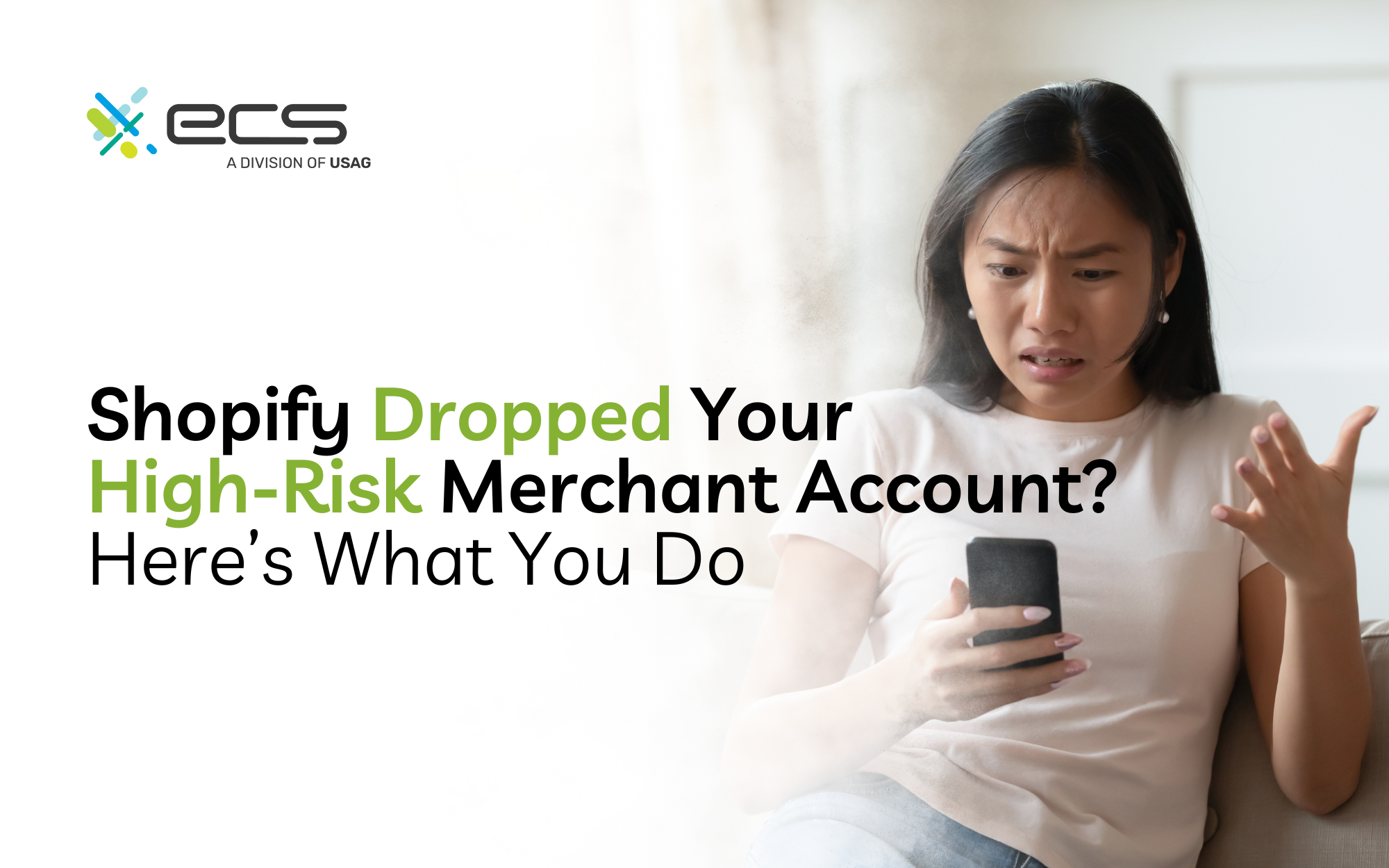Without a doubt, if your Shopify high-risk merchant account is frozen, you have some work ahead of you. There are many reasons this could happen and it’s never a welcome surprise. Our goal is to help you better understand why this happens and what to do about it.
From Shopify’s market presence, you might think it was the largest (if not only) eCommerce platform out there. Although it’s not. It’s the third after Amazon and Walmart. However, it is arguably the largest platform for independent businesses that want to sell goods under their own logo.
There are more than 2 million daily Shopify users who have collectively placed one billion orders. Generating $319 billion in global economic activity. With stats like that, it’s no wonder that Shopify’s rate of growth has been nearly three times that of the eCommerce market in general.
It’s easy to see why small businesses want to join the Shopify Community. Their drag-and-drop website-building platform makes it easy to create professional-looking storefronts. The Shopify logo is a strong trust indicator for customers. And Shopify does integrate well with other apps and plugins that facilitate (among other things) social media marketing.
But for high-risk merchant accounts, Shopify may not be the best option for collecting payments. And as it turns out, Shopify itself might be the first one to let you know by dropping your account.
What is Shopify?
Shopify is a widely known e-commerce platform that allows small businesses and individuals to create and manage their online stores. The platform provides a variety of features and tools that make it easy to set up, design, and manage their eCommerce store and business website including the following:
Website Builder
Users need zero coding or design experience to use Shopify’s easy-to-use website builder. Merchants can customize their websites with a variety of design templates and themes to create a professional-looking website that reflects their unique brand.
Shopping Cart
Shopify’s shopping cart system allows customers to add items to their online cart, make adjustments in quantities, and process a secure payment at checkout. The Shopify platform supports multiple payment avenues, including credit cards, debit cards, PayPal, Apple Pay, and more.
Inventory Management
Shopify’s powerful inventory management tools allow merchants to track their stock levels. Alerts can be set to warn when stock is low and new inventory orders need to be placed.
Marketing Tools
Shopify’s diverse set of marketing tools can help merchants attract new and retain loyal customers. These marketing tools include email marketing, social media integration, SEO optimization, and discounts and promotions platforms.
Analytics and Reporting
Merchants can optimize their eCommerce store’s performance and improve their customer experience by utilizing analytics through Shopify’s detailed reporting tools. Track sales, consumer behavior patterns, and other important metrics.
App Store
Shopify also offers an extensive app store that includes a wide range of third-party apps and integrations to enhance its platform functionality. These apps can provide support for tasks such as marketing, shipping, and accounting.
Overall, Shopify’s eCommerce and website-building platform is versatile and makes it easy for small businesses and large to create and manage their online store. Its user-friendly interface, robust features, and extensive app store make it a popular choice amongst eCommerce entrepreneurs around the globe.
How Do Payments Work on Shopify?
Shopify Payments
One way of collecting payments with a Shopify store is to use Shopify Payments. Shopify Payments is their in-house, integrated solution sort of… (more on that later). Remember that Shopify is an all-in-one eCommerce platform that can provide payment processing.
But merchants are not required to use Shopify Payments. Even if they have a Shopify store. The upside to Shopify Payments is that it comes with a platform and can be activated instantly. Without a lengthy application.
Merchants who choose to accept Shopify Payments will also get paid through Shopify. In the U.S., merchants will be able to accept major credit cards like Visa, Mastercard, American Express, Discover, and even throwbacks like Diner’s Club. There’s also a Shopify Lite option that allows merchants with their own website or selling on their social media channels to add a Shopify Payments button.
Processing Fees
Shopify payment processing fees are graduated based on your pricing plan. If you have a basic plan at $29 per month, online payments are subject to a 2.9% fee plus 30 cents per transaction. That drops to 2.6% and 30 cents per transaction for the $79 standard plan, and down to 2.4% and 30 cents per transaction for the $299 advanced plan.
Tangentially, if you’re wondering why a small business would pay ten times the cost of the basic plan per month, the advanced features allow for up to 15 staff accounts and customized report building.
Getting Paid
In terms of getting paid, merchants can receive funds in their bank in accordance with a payment schedule. Or, if they use a Shopify Balance account, they can collect their payments as quickly as in one business day. It might take their acquiring bank 24-72 hours to finally settle the payments, however.
For merchants who use Shopify Payments to collect transactions, fewer things can be more frustrating than seeing that your payments are on hold. And that might occur if Shopify flags your business for high-risk, even if you initially met their requirements.
What Are The Requirements For Using Shopify Payments?
There are certain requirements for using Shopify Payments. Such factors would include country and currency specifications, as well as risk level and chargeback ratio.
Country Specifications
Only merchants in 17 countries can use Shopify as a payment processor. These countries include the United States, the United Kingdom, Canada, Australia, New Zealand, Ireland, Japan, Singapore, Hong Kong, and most continental European countries.
As you can see, English-speaking countries make up about 33% of the list, which perhaps accounts for Shopify’s synonymous image with eCommerce in these places. But if your IP address is located outside this list of 17 places, you won’t be able to use it.
Currency Specifications
Another requirement would be to have a bank account for Shopify that uses your country’s currency and accepts electronic money transfers. In the case of American merchants, that means a physical bank that accepts ACH payments. Virtual accounts and flex currency accounts are not able to support Shopify ACH Payments.
Risk-Level
Another requirement is that you are not engaged in a high-risk business. There is no universal standard of what constitutes a high-risk industry, but for Shopify, that list includes highly regulated industries, tech services, legal services, and anything that’s not a tangible physical product.
Large orders can also be flagged as Shopify high-risk orders and get a high-risk merchant label applied to your Shopify store. This is especially the case if certain orders are very much outside the bell curve of a typical sale, for instance, a $10,000 order at a store where the average order is under $100.
Chargeback Ratios
Another requirement is a low chargeback rate. Chargebacks are different from refunds in that the customer skips the return process entirely and instead files a dispute with their bank or credit card company.
The end result is a cascade of fees that the acquirer and the payment processor have to pay to undo the mess that’s created and of course, they pass these fees on down to the merchant, who has not only lost a sale but now must pay $20 to $200 (or more) in fees on top of that.
If you were initially accepted by Shopify, that means you were probably not considered a high-risk merchant service. But if suddenly, you were labeled a Shopify high-risk merchant and they will no longer process your payments, it could be related to your history as a merchant or your business activities.
For instance, excessive chargebacks or complaints of credit card fraud. At that point, if you want to continue collecting payments, you’ll have to open a high-risk merchant account under a payment provider that works with high-risk businesses.

What is a Payment Aggregator?
A payment aggregator is a third-party payment processor that signs up merchants under its own merchant ID to process payments. Payment gateways like PayPal are payment aggregators. These solutions have their benefits for small businesses. For instance, they take much of the backend headache in terms of compliance and operations of the merchant.
They have simple fee structures, a speedy approval process, and a generally easy application process void of credit checks or a scrutinous review of your business model. But the upsides of payment aggregators are also their downsides. Simple fee structures do not benefit every type of business. Once a business starts heading toward a higher transaction volume, the cost efficiency of partnering with a payment aggregator may begin to decline.
And the ease of approval in the application process is balanced out by the increased possibility of account holds. While these holds often last 24-48 hours, in some cases they may be longer, resulting in significant disruptions to your business.
Shopify is a Payment Aggregator For Stripe
It is important to note that Shopify is not a payment processor, but rather a platform that integrates with payment processors to facilitate transactions. Shopify Payments is in reality a white-label version of Stripe. Which means that Shopify Payments is also a payment aggregator. To explain further: white labeling is when one business offers goods or services under its own label, but those goods or services are actually provided by another business.
Shopify store owners might be very familiar with this principle. Because white labeling is one of the biggest trends in eCommerce. It allows individual business owners to sell a variety of goods they don’t produce. And in some cases (e.g. dropshipping) don’t fulfill either.
A business simply packages the presentation to be consumer-facing, without making the products and in some cases, never even seeing them.
So with that in mind, you will have a better understanding of what Shopify Payments is. Shopify Payments is not a Shopify bank or even a payment gateway that works with your business individually.
It’s an aggregated merchant account. One that essentially pools millions of businesses together under its own merchant ID, Shopify accounts, moreover, are actually not really Shopify products, it’s Stripe. Shopify has just repackaged it to fit more seamlessly into the merchant end of things.
That’s not to say that Stripe is something to scoff at. Stripe has already surpassed a $96 billion market valuation, with 2 million customers around the world, and 3.1 million websites using Stripe to collect payments. Around 13,000 payments are being processed by Stripe every second, and some of Stripe’s biggest customers include Google, Amazon, and Salesforce.
Downsides to Working with a Payment Aggregator
But in this case, bigger does not mean better.
Mitigating Their Own Risk
As mentioned, one drawback to the approach of working with a payment aggregator (for the individual merchants) is that they are more concerned with mitigating their own risk than your ease of collecting payments, which can sometimes result in holds, freezes, or suspensions.
Poor Customer Support
There are a few other issues with payment aggregators. One is that they tend to have very poor customer support. If your payments are frozen, there will be some sort of internal review process for determining the next course of action.
Additionally, you will have limited resources for discussing the issue with live human beings. That’s not the case with a smaller payment processor, especially one that is dedicated to working with high-risk merchant accounts.
Fee Structure
Another drawback to payment aggregators is the pricing structure. As mentioned, payment aggregators tend to have very simple fee structures.
For example, in the case of Shopify Payments, there is a graduated payment structure based on what type of pricing plan you have. But shouldn’t the fee structure be based on sale volume? That is, shouldn’t you be charged less if you are bringing a greater volume of transactions to the processor?
That’s kind of the normal operating rule in business, move volume means a bigger discount. But Shopify has created a fairly uniform payment structure that disregards volume and instead promotes getting an upgraded account.
A non-aggregate payment processor, by contrast, will be able to offer you a more tailored pricing plan that is better for your bottom line, especially as you move toward a higher volume of transactions.
White-label
Finally, another downside of Shopify Payments is it being a white-labeled version of Stripe. In this case, Shopify must adhere to Stripe’s rules in terms of what constitutes risk. And since Stripe itself is a massive aggregator with many sub-merchants (businesses like yours), they are going to make sure they mitigate their own risk and quickly shut down anything that sends up a red flag…even if they are misreading the situation.

Why did Shopify Close My Store?
Remember that Shopify Payments is part of the Shopify platform. But Shopify merchants are not required to use it in order to process payments. If Shopify will not service your payments because they consider you a high-risk merchant, that’s one thing.
But if Shopify wants to close your store down entirely, you’ve got bigger fish to fry, e.g., finding a new platform and not just a payment processor for your Shopify merchant ID.
Violation of Terms of Service
Shopify will suspend your account if you are violating their terms of service. For instance, selling illegal items, or violating copyright laws. Here are a few items sales that will make Shopify close your account: alcohol, tobacco, CBD, fireworks, firearms and weapons, solvents, and pharmaceuticals (and most certainly if you’re selling all those things in one place).
High-Risk Label
But if you’re not selling any items that are expressly prohibited by Shopify’s terms of service, you’re not violating any copyright laws, you’re not doing anything illegal or fraudulent and you’ve still been labeled a Shopify high-risk account, then you’ll need to look for a special type of payment processor: one that works with Shopify high-risk merchant accounts, or high-risk merchant accounts in general.
Potentially High Chargeback Ratios
Of course, there is the issue of chargebacks. If you run a legitimate business but experience a chargeback ratio of more than 1% (which seems fairly low), most payment processors will consider you high-risk.
While it’s easy to think of chargebacks only being an issue for an unethical business, even a well-intentioned business can see an increase in chargebacks if they cannot be reached easily for customer support. That said, how you run your business may be a contributing factor in terms of being labeled high-risk.
Then sometimes there are events that are totally beyond your control. Such as a large order size that is outside the scope of your usual order volume. This may be a red flag that gets your account flagged, frozen, or suspended.
And as mentioned earlier, with large payment aggregators, it can be hard to find the right person to talk to over the phone or via email as you attempt to get your account unlocked.
As mentioned, there are some types of products that are outright banned on Shopify. Others are not banned from using the Shopify platform but are labeled by Shopify as high-risk merchants. An example would include herbal supplements.
Although it is forbidden per Shopify’s terms of service to sell prescription pharmaceuticals, merchants may be able to sell herbal supplements. But herbal supplements present risks to payment processors. Some customers may initiate a chargeback if they end up not liking the product or don’t realize any benefit.
There may also be potential legal challenges in which Shopify does not want to become embroiled if a supplement ends up being dangerous. For these reasons, a merchant selling supplements on Shopify will probably be labeled a high-risk merchant. They would then need to look among high-risk payment processors for Shopify businesses.
Service-Based Business On Shopify
Another reason Shopify could pause your store account from its payment gateway is that you are offering services or digital goods instead of a tangible good. This is because these types of businesses are easy to run scams through because it’s difficult to prove receipt of merchandise.
This lack of transparency makes it easier to conduct some type of illegal business behind the facade of providing a service like web design or consulting. By the time this issue is figured out, it’s too late for the banks to straighten out the mistake. Shopify would rather mitigate its involvement in these types of businesses to avoid legal trouble.
As a side note, you are allowed to sell services on Shopify. But in some cases, these services may get you classified as needing Shopify high-risk payment processors to collect your money. But as it turns out, there may be better platforms for a service-based business, especially if you are selling digital information-based products.
While some of these platforms will offer an in-house payment processor, others will not. Which means you will need your own. Moreover, the ones that do, typically take very large fees.
For instance, Udemy (an online education platform) sometimes takes fees of up to 50%. With fees like that, it’s better to build your own website on a customizable platform and get your own payment processor for your dedicated merchant account.
Poor Merchant Credibility
In a similar vein, if your business is in an industry that is rife with a history of scamming, this will not look good for you. One example is tech support, whereby 24,000 people reported losing a collective $347 million as recently as 2021. A 137% increase from the previous year.
Shopify does not want to be involved in this type of risk, so businesses they perceive as risky by association will need to use a different payment processor.

So What Should You Do When Shopify Drops Your High-Risk Merchant Account?
Many e-commerce platforms, including Shopify, have been known to drop high-risk merchant accounts. It may seem like a harsh move, but it is done to protect the platform and other merchants from potential financial losses.
If Shopify has canceled your merchant account, it is important to take immediate action to address the situation so your business doesn’t skip a beat. Here are some steps you can take:
Contact Shopify
First and foremost, you should attempt to resolve the issue with Shopify as quickly as you can. Email or call Shopify’s customer support team to find out why your merchant account was canceled. Shopify may provide you with specific reasons for the cancellation, and it is important to understand these reasons to determine your next steps.
Review Your Industry Regulation Compliance
Beyond unapproved merchandise, certain merchants including high-risk merchant accounts can often be canceled with Shopify due to non-compliance with industry regulations, such as anti-money laundering (AML) and know-your-customer (KYC) regulations. Review your compliance with these regulations and ensure that you are meeting all requirements.
Ensure Sufficient Fraud Prevention Measures Are in Place
Fraud is a major concern for all payment processors and hosted eCommerce platforms. Make sure to review your fraud prevention measures, such as two-factor authentication, address verification, PCI-compliance standards, and transaction limits, to ensure that they are sufficient.
Seek Out Alternative Payment Processors
In the meantime, if your merchant account was canceled due to risk factors, you should immediately look for a new payment processor that specializes in high-risk industries and merchants. Research alternative payment processors and find one that is willing to work with you.
The truth of the matter is that Shopify may not be the best option for supporting your business and its method of collecting payments. Since it is a payment aggregator with very little operational leeway.
A smaller payment processor can instead provide a high-risk payment gateway for your Shopify store. And ironically enough, Shopify might just be the one to push you in the right direction by dropping your account.
Review Your Business Model
If your merchant account was canceled due to the nature of your business, you may need to review your business model and make any appropriate changes. Consider diversifying your products or services, targeting a different customer demographic, or changing your marketing strategies. Especially ensuring your marketing is transparent.
Appeal Shopify’s Decision
If you feel that your merchant account was canceled unjustly, you may be able to appeal their decision. Reach out to Shopify’s customer support team and ask if there is an appeals process. If you know your products are accepted on Shopify’s platform, be sure to provide any additional information that may help your case, such as evidence of compliance with industry regulations or robust fraud prevention measures.

Consider Taking Legal Action
Lastly, if you believe that your merchant account was canceled unfairly and in violation of your rights, you may need to consider legal action. Especially if they do not let you submit an appeal. Consult with a lawyer who specializes in eCommerce and payment processing to determine your options.
But in the end, legal battles are always a headache and can cost you more money than you should pour into such a thing. It may be in your best interest to simply go back to step 4 and seek out alternative payment processing options.
No matter what, it is important to act quickly if your merchant account has been canceled by Shopify. By taking steps to address the situation, you may be able to find an alternative payment processor or appeal the decision entirely. If all else fails, consider making changes to your business model or seeking legal action to protect your interests.
To contact sales, click HERE. And to learn more about ECS High-Risk Merchant Accounts visit High-Risk.
